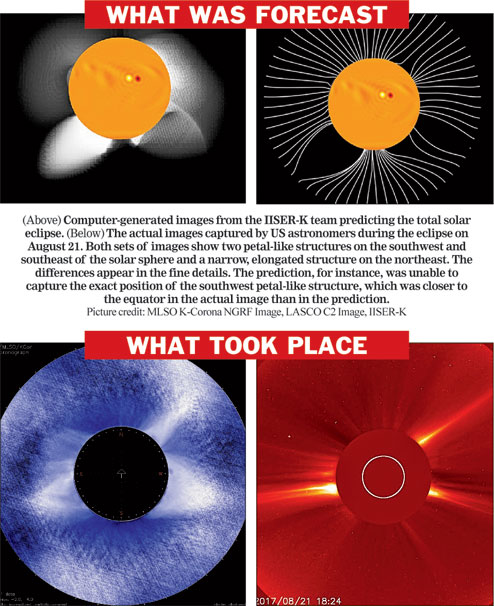
New Delhi, Aug. 23: Indian scientists correctly predicted key features of the solar corona ahead of Monday's total solar eclipse in America, sections of astronomers said tonight, describing it as "an impressive feat" done with limited computing resources.
A preliminary analysis has suggested that the solar corona displayed petal-like structures, called helmet-streamers, on the southeast and southwest of images of the solar sphere and a third narrow elongated streamer on the northeast, as predicted by scientists at the Indian Institute of Science Education and Research, Kolkata.
Astronomers who compared the IISER-K's computer-generated images and actual images captured by US scientists during the eclipse said the prediction was unable to capture some fine details, but the overall forecast was satisfactory and added confidence to their prediction strategy.
A team at IISER-K led by solar physicist Dibyendu Nandi had released images predicting the shape of the corona - the hot jacket of gas surrounding the Sun - which becomes visible only during a total solar eclipse.
"The close correspondence between the prediction and observations of the major features is an impressive feat for a first attempt with limited computing resources, without recourse to supercomputers," said Durgesh Tripathi, an astrophysicist at the Inter-University Centre for Astronomy and Astrophysics (IUCAA), Pune, who was not part of the prediction team.
Scientists say the success at this first prediction of the features of a solar eclipse will allow India's astronomy community to move towards more complex predictions of the space environment around the Earth.
Solar physicists across the world are trying to understand the solar corona better. Ejections of material from the Sun's surface can trigger space weather storms that originate in the solar corona and may disrupt satellite and telecommunications.
The IISER-K team collaborating with a scientist at Durham University in the UK assumed that the overall structure of the corona was not heavily dependent on the most recent sunspots on the solar surface. They assumed, instead, that the corona's features would be primarily influenced by the history of how the magnetic field changed on the Sun's surface.
The scientists modelled the magnetic field distribution as expected on the day of the eclipse to predict and used the pattern to predict the corona's features.
"They will be performing a more detailed analysis as more data comes in, but we are satisfied with the overall success of the prediction," Somak Raychaudhury, director of IUCAA, said in a news release.
Other members of the prediction team were Prantika Bhowmik, Suman Panda, Rajashik Tarafder and Soumyaranjan Dash at IISER-K and Anthony Yeates from Durham University.










